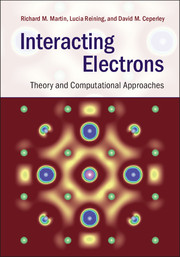Book contents
- Frontmatter
- Dedication
- Contents
- Preface
- Acknowledgments
- Notation
- Part I Interacting electrons: beyond the independent-particle picture
- 1 The many-electron problem: introduction
- 2 Signatures of electron correlation
- 3 Concepts and models for interacting electrons
- Part II Foundations of theory for many-body systems
- Part III Many-body Green's function methods
- Part IV Stochastic methods
- Part V Appendices
- References
- Index
2 - Signatures of electron correlation
from Part I - Interacting electrons: beyond the independent-particle picture
Published online by Cambridge University Press: 05 June 2016
- Frontmatter
- Dedication
- Contents
- Preface
- Acknowledgments
- Notation
- Part I Interacting electrons: beyond the independent-particle picture
- 1 The many-electron problem: introduction
- 2 Signatures of electron correlation
- 3 Concepts and models for interacting electrons
- Part II Foundations of theory for many-body systems
- Part III Many-body Green's function methods
- Part IV Stochastic methods
- Part V Appendices
- References
- Index
Summary
Real knowledge is to know the extent of one's ignorance.
Confucius, 500 BCESummary
The topic of this chapter is a small selection of the vast array of experimentally observed phenomena chosen to exemplify crucial roles played by the electron– electron interaction. Examples in the present chapter bring out the effects of correlation in ground and excited states as well as in thermal equilibrium. These raise challenges for theory and quantitative many-body methods in treating interacting electrons, the topics of the following chapters.
The title of this book is Interacting Electrons. Of course, there are no non-interacting electrons: in any system with more than one electron, the electron–electron interaction affects the energy and leads to correlation between the electrons. All first-principles theories deal with the electron–electron interaction in some way, but often they treat the electrons as independent fermions in a static mean-field potential that contains interaction effects approximately. As described in Ch. 4, the Hartree–Fock method is a variational approximation with a wavefunction for fermions that are uncorrelated, except for the requirement of antisymmetry. The Kohn–Sham approach to DFT defines an auxiliary system of independent fermions that is chosen to reproduce the ground-state density. It is exact in principle and remarkably successful in practice. However, many properties such as excitation energies are not supposed to be taken directly from the Kohn–Sham equations, even in principle. Various other methods attempt to incorporate some effect of correlation in the choice of the potential.
This chapter is designed to highlight a few examples of experimentally observed phenomena that demonstrate qualitative consequences of electron–electron interactions beyond independent-particle approximations. Some examples illustrate effects that cannot be accounted for in any theory where electrons are considered as independent particles. Others are direct experimental measurements of correlation functions that would vanish if the electrons were independent. In yet other cases, a phenomenon can be explained in terms of independent particles in some effective potential, but it is deeply unsatisfying if one has to invent a different potential for every case, even for different properties in the same material. A satisfactory theory ultimately requires us to confront the problem of interacting, correlated electrons.
- Type
- Chapter
- Information
- Interacting ElectronsTheory and Computational Approaches, pp. 15 - 39Publisher: Cambridge University PressPrint publication year: 2016



